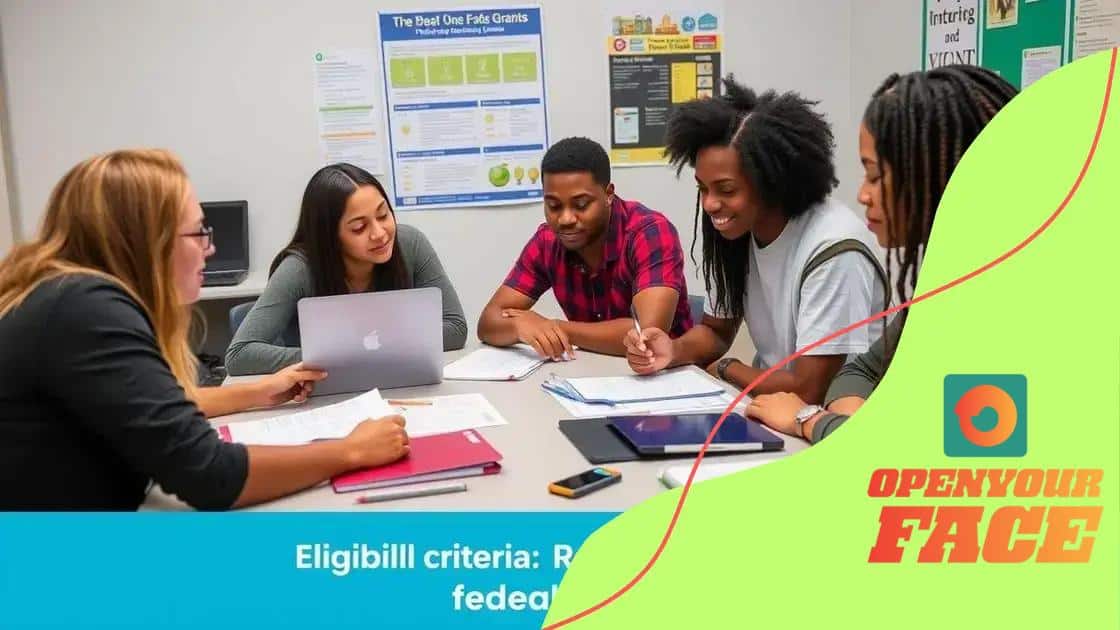Federal grants for low-income students in 2025

Federal grants for low-income students in 2025 provide essential financial support, including Pell Grants and SEOG, allowing students to afford college education without repayment burdens.
Federal grants for low-income students in 2025 are more accessible than ever, opening doors to affordable education. Are you curious about how to take advantage of these opportunities? In this article, we will explore the grants available and how to navigate the application process.
Understanding federal grants for low-income students
Understanding federal grants for low-income students is crucial for many aspiring college attendees. These grants provide essential financial support, making higher education more accessible. In 2025, various programs are available that specifically target those in need, ensuring that students can achieve their educational goals without the burden of overwhelming debt.
What Are Federal Grants?
Federal grants are funds that do not have to be repaid, which makes them a popular choice for funding higher education. The government allocates these grants based on financial need, allowing low-income students to focus on their studies rather than their finances.
Types of Federal Grants
Here are some of the most common federal grants available:
- Pell Grant: This is the largest federal grant program, aimed at students from low-income families.
- Supplemental Educational Opportunity Grant (SEOG): These grants are awarded to students with exceptional financial need and are usually provided through the college.
- TEACH Grant: For students who wish to become teachers in high-need fields, this grant offers financial assistance in exchange for a service obligation.
- Federal Nursing Student Loans: While not technically a grant, these loans assist nursing students with their educational costs.
To apply for these grants, students must fill out the Free Application for Federal Student Aid (FAFSA). This application is essential, as it determines eligibility and the amount of funding a student can receive. Additionally, it is important to keep an eye on deadlines for grant applications to ensure no opportunities are missed.
Students should also remember that funding levels can vary each year. Researching current funding levels can help in planning for future expenses. In addition, there are often state grants and scholarships that can complement federal funding, providing even more financial relief.
Lastly, understanding the implications of federal grants and maintaining communication with financial aid offices can enhance a student’s education funding journey. Take advantage of these resources, and don’t hesitate to ask questions during the grant application process.
Eligibility criteria for 2025 grants

Understanding the eligibility criteria for 2025 grants is essential for students seeking financial aid. These criteria help determine who can receive federal grants based on specific requirements set by the government.
Basic Eligibility Requirements
To qualify for most federal grants, students must meet a few basic requirements:
- Citizenship: Applicants must be U.S. citizens, nationals, or eligible non-citizens.
- Financial Need: Students must demonstrate financial need, typically assessed through the FAFSA.
- Enrollment Status: Students need to be enrolled or accepted for enrollment in a degree or certificate program at an eligible institution.
- Academic Standards: Students should maintain satisfactory academic progress as defined by their school.
Additionally, it’s crucial for applicants to keep track of their standing in relation to these criteria. For example, if a student’s family income changes, they might become eligible for more grant funding. Regularly updating FAFSA information helps ensure that students receive the aid they need.
Special Circumstances
In 2025, various grants may also have specific eligibility requirements based on unique circumstances:
- Previous Recipients: Students who have received federal aid before might have different criteria.
- Field of Study: Some grants target students in high-demand careers or fields of study.
- Demographic Factors: Certain programs may focus on underrepresented groups or students facing particular challenges.
Understanding these special requirements can open additional funding opportunities. Students should research various grant programs to see if they qualify under unique criteria, which might not be part of standard federal grants. By being informed, students can improve their chances of receiving the necessary funding.
How to apply for federal grants
Applying for federal grants is a straightforward process, but it requires attention to detail. Understanding how to navigate this process can significantly enhance your chances of receiving financial aid.
Step-by-Step Application Process
The first step in applying for federal grants is to complete the Free Application for Federal Student Aid (FAFSA). This form gathers essential information about your financial situation and needs. Here are the steps involved:
- Gather Required Documents: Before starting the FAFSA, collect necessary documents such as tax returns, bank statements, and information on assets.
- Visit the FAFSA Website: Go to the official FAFSA website where you will find an easy-to-follow application.
- Fill Out the Application: Provide accurate and complete information. Mistakes can delay the processing of your application.
- Submit Your FAFSA: After filling out the form, review your information and submit it before the deadline.
Once you submit your FAFSA, it typically takes a few days to process. You’ll receive a Student Aid Report (SAR), which summarizes your financial information and provides your Expected Family Contribution (EFC).
Understanding Award Offers
After your FAFSA is processed, colleges will use the information to determine your eligibility for federal grants. Once they assess your financial need, they will send you an award letter detailing the types and amounts of aid you qualify for.
Comparing award letters from different colleges can help you make informed decisions about where to attend. It’s essential to accept only the financial aid you genuinely need.
Tips for Completing the Application
Here are some valuable tips for maximizing the effectiveness of your grant application:
- Pay Attention to Deadlines: Make sure to understand state and federal deadlines, as missing them may result in losing eligibility for certain grants.
- Be Honest: Accurately report your financial situation. Fraudulent information can lead to penalties or denial of aid.
- Seek Assistance: If you need help, don’t hesitate to ask financial aid advisors at your school or local community organizations.
By following these steps and tips, students can confidently navigate the process of applying for federal grants. This proactive approach can open doors to financial resources and support educational aspirations.
Types of federal grants available

There are various types of federal grants available to assist low-income students in achieving their educational goals. Understanding these grants can help students take full advantage of financial aid opportunities.
Pell Grants
The Pell Grant is one of the most popular and widely recognized federal grants. It is specifically aimed at undergraduate students from low-income families. Pell Grants provide much-needed funding that does not have to be repaid. These grants are based on financial need, determined by information submitted in the FAFSA.
Supplemental Educational Opportunity Grants (SEOG)
SEOG grants are another source of aid for students with exceptional financial need. These grants are awarded to students who also receive Pell Grants, offering them additional financial support. SEOG grants are administered directly by colleges, with funding varying by institution.
TEACH Grants
TEACH Grants are designed for students who plan to become teachers in high-need fields. To qualify, students must agree to serve as a teacher at a low-income school for a specified period. If they do not fulfill this obligation, the grant is converted into a loan that must be repaid.
Federal Nursing Student Loans
While not a grant in the traditional sense, Federal Nursing Student Loans provide financial assistance to nursing students. These loans have favorable terms and can be repaid based on income after graduation, easing the financial burden as students start their careers.
National Science and Mathematics Access to Retain Talent Grant (SMART)
For students pursuing degrees in science, technology, engineering, or mathematics (STEM), the SMART grant provides additional funds. This grant is aimed at helping students who demonstrate financial need and maintain a specified GPA during their course of study.
Understanding these different types of federal grants is crucial for students looking to finance their education. Each grant has unique eligibility requirements and specific benefits, so it’s important to carefully consider which options best fit your situation.
Tips for maximizing your federal grant funding
Maximizing your federal grant funding can make a significant difference in your educational journey. With careful planning and strategic actions, you can ensure that you make the most of the financial resources available to you.
Understand Your Grants
The first step to maximize your funding is to fully understand the types of grants you are eligible for. Each grant may have different requirements, use cases, and funding amounts. Take the time to read the details about each grant you qualify for and know how it can best support your education.
Stay Organized
Keeping your financial documents organized is essential. Regularly update your records, including tax returns and income statements, to reflect any changes in your situation. Use a filing system, either digital or physical, to ensure easy access to important documents.
Apply Early and Frequently
Don’t wait until the last minute to submit your FAFSA or grant applications. Applying early can increase your chances of receiving funding and allow you to explore all available options. Additionally, consider applying for state and institutional grants, as they might complement federal aid.
Maintain Your Eligibility
It’s crucial to understand and maintain the eligibility requirements for your grants. Keep track of academic performance and ensure you are meeting any criteria. For example, ensuring a certain GPA or completing necessary coursework on time can help retain your funding.
- Keep in Touch with Financial Aid Advisers: Connect with your school’s financial aid office. They can provide valuable insights and updates on available funding and requirements.
- Explore Additional Scholarships: Federal grants can often be complemented by scholarships from private organizations, community groups, or other sources. Researching these opportunities can provide additional funds.
- Use Award Money Wisely: Once you receive your grant, create a budget. Allocate funds responsibly to cover tuition, books, and living expenses.
By following these tips, you can maximize your federal grant funding and focus more on your studies rather than financial stress. Remember that being proactive and informed can lead to successful outcomes in your educational pursuits.
In summary, understanding and leveraging federal grants for low-income students can greatly enhance educational opportunities. By being informed about the types of grants available, the eligibility requirements, and how to apply, students can position themselves for success. Additionally, utilizing strategies to maximize grant funding will help in managing educational costs effectively. Stay proactive and engaged throughout the financial aid process, and make the most of the resources at your fingertips!
FAQ – Frequently Asked Questions about Federal Grants for Low-Income Students
What is the Pell Grant?
The Pell Grant is a federal financial aid program for low-income undergraduate students that does not require repayment.
How do I apply for federal grants?
To apply for federal grants, you need to complete the Free Application for Federal Student Aid (FAFSA) each year.
What types of federal grants are available?
Some common federal grants include Pell Grants, Supplemental Educational Opportunity Grants (SEOG), and TEACH Grants for future teachers.
How can I maintain my eligibility for federal grants?
To maintain eligibility, you must meet academic standards, submit your FAFSA on time, and keep track of your enrollment status.






